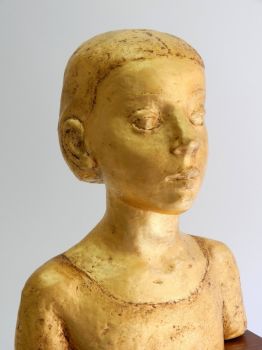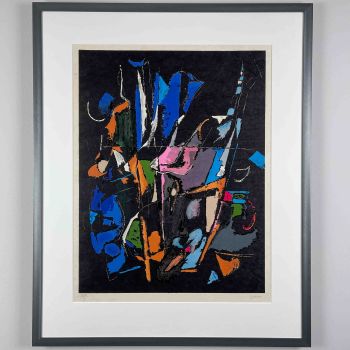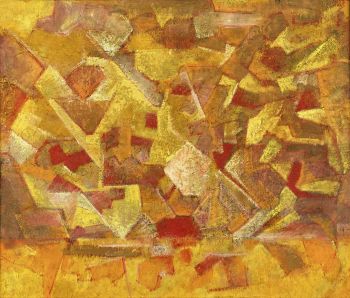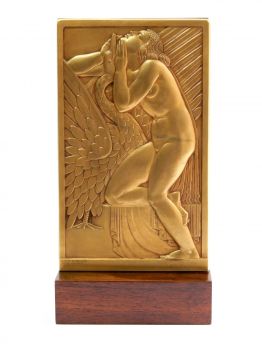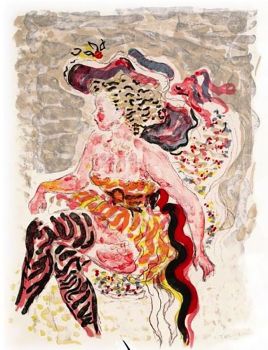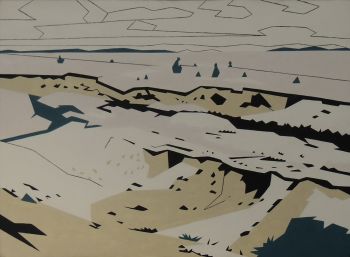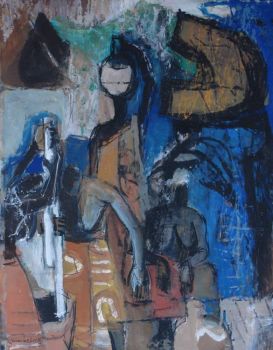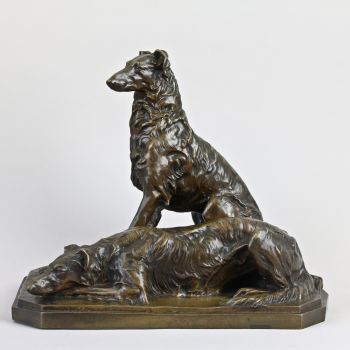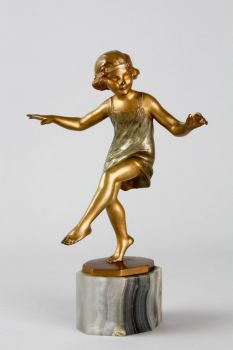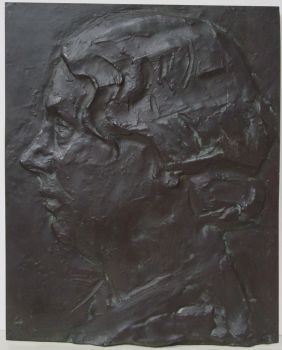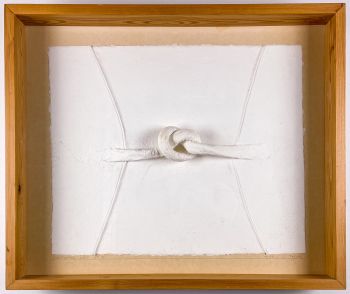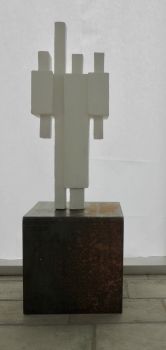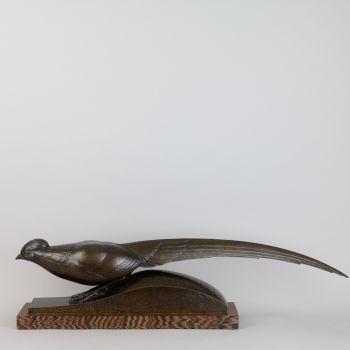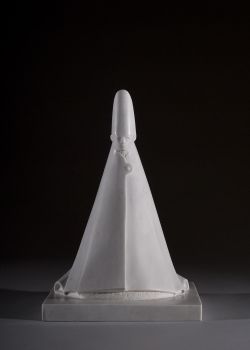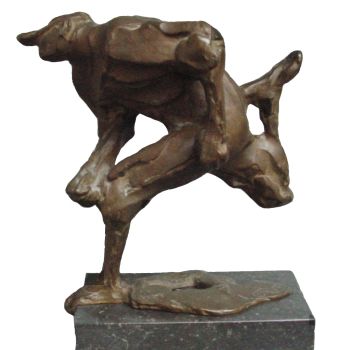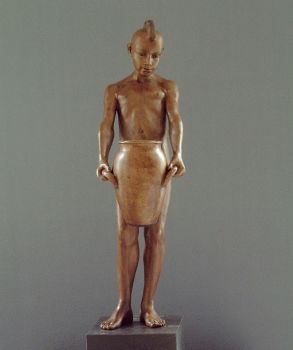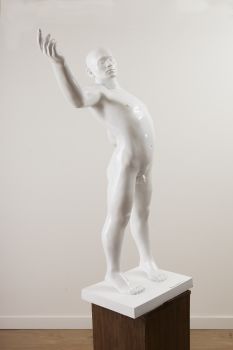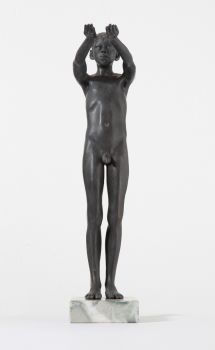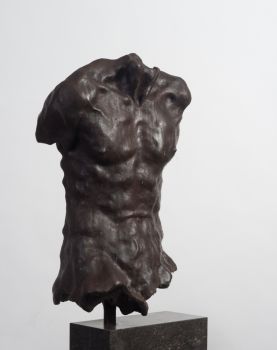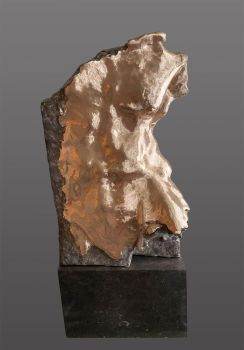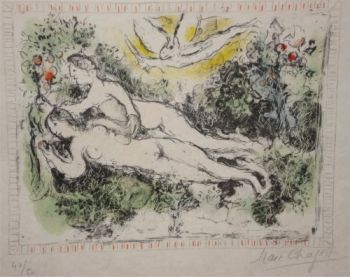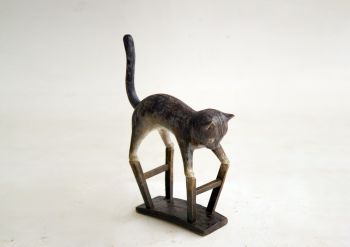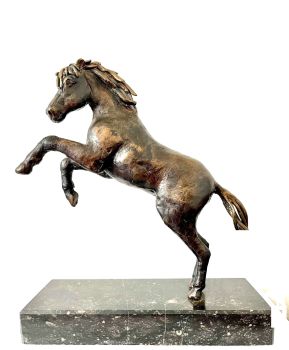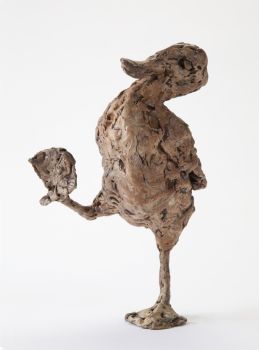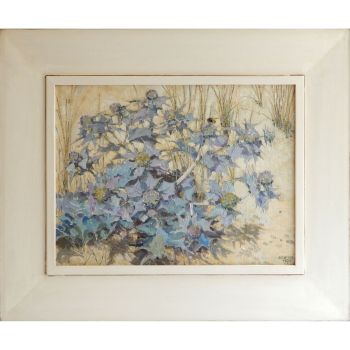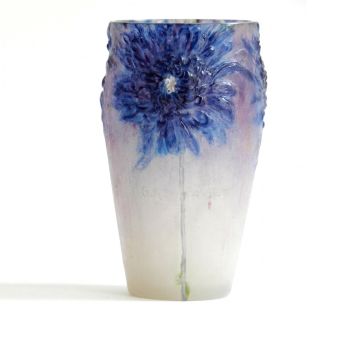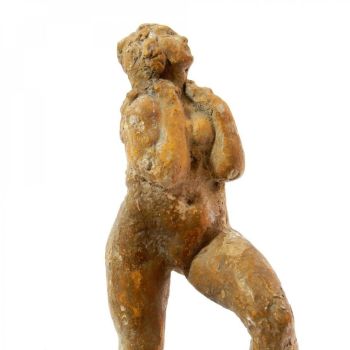l'Homme nu' 1936 - 2022
Léon Indenbaum
BronsMetaal
67 cm
ConditionExcellent
Prijs op aanvraag
Dille Art
- Over kunstwerkBeautiful bronze of a male nude, the man stands there with his hands at his sides, his cap still on, tough and vulnerable at the same time.
Posthumously cast bronze, cire perdue cast from the original plaster of 1936. The original plaster is in the possession of his family.
The sculpture is signed with 'Inden', 'Cire perdue' and the hallmark of the bronze founder 'FBL' (Fonderie de Bronze Lauragaise) and the number 'EA II/IV'.
The bronze sculpture is an original first edition, numbered 1-8 and EA (Epreuve d'artiste) from II-IV. This sculpture has number EA II/IV.
This sculpture also comes with an official certificate signed by Léon Indenbaum's grandson.
The bronze is registered with ADAGP (Société des auteurs dans les arts graphiques et plastiques) Paris.
Biography:
Leon Indenbaum (Tcherikov, now Belarus, 1890 - Opio, 1981), was a Russian/French sculptor who belonged to the group of artists of the École de Paris. His art was innovative, inspired by the classics, but also by African art, the Cubism and Expressionism.
Léon Indenbaum grew up in the shtetl (Eastern European Jewish village) Tcherikov, with his grandfather, who was a bookbinder of art books. After primary school, he was educated as a woodworker. The director of that school thought he was so talented that he arranged for him to attend the Academy of Decorative Arts in Vilnius.
After this training, Indenbaum wanted more and was admitted to the Imperial Academy in Odessa. He went through it for a few years until he crossed a wrong box on a form, he had accidentally signed for 5 years military service in the Imperial Army.
He already had contacts with an artist friend who was in Paris, where so much was happening in the field of art.
Indenbaum managed to escape from Vilnius with the help of an engineer and arrived in Paris in March 1911.
He ended up in 'La Ruche' in Montparnasse, a kind of artists' village.
La Ruche was a circular building, it served as a wine pavilion at the 1900 World's Fair, and was rebuilt by the successful artist Alfred Boucher. Boucher wanted to give poor artists a chance to devote themselves completely to their art. La Ruche was a large round building full of studio apartments, each room had the shape of a slice of pie, in the point a space for a kitchen and storage and above the door was a small loft where you could sleep, often such a studio also had to be shared.
Indenbaum got a studio on the 2nd floor, next to Chagall, who, like himself, had also just arrived from Russia. Indenbaum lived in La Ruche until 1927.
He did have a second studio in Montparnasse for a while.
In total, about 200 artists lived in La Ruche, many of them were from Eastern Europe and many of them were Jewish. Some of them have become world famous with their art, think of Chaïm Soutine, Ossip Zadkine, Jacques Lipschitz, Chana Orloff, Michael Kikoïne, Moïse Kisling , Amadeo Modigliani to name a few.
From 1911 to 1919, Indenbaum studied sculpture at the Académie La Grande Chaumière, his mentor was the sculptor and painter Antoine Bourdelle, first as a student, later also as his assistant.
In 1912 Indenbaum already exhibited at the Paris Salon d'Artistes Indépendents, he was very poor and his choice of materials was cheap.
Jacques Doucet, the great art collector and famous couturier, saw a bust of Indenbaum and summoned him to his home, he wanted the same bust made in a different material. Indenbaum managed to get a piece of onyx.
Doucet was very pleased and asked Indenbaum to make a relief for his round dining room. Indenbaum received 1000 francs per month.
Indenbaum had found his patron.
He made one of his most impressive reliefs, entitled 'Musiciens et antelopes' from 1914, made of pink onyx. It was auctioned at Christie's in 2004 for 3.3 million euros.
Besides Jacques Doucet, the couturier René Poiret, the bankers George and Marcel Bénard and the decorator, designer and collector Marcel Coard were regular customers of Léon Indenbaum's sculptures and reliefs.
Léon fell in love with Céline Hénin, she became his muse and his wife, at the end of 1914 they had a daughter, Dinah. Indenbaum was doing well. He had many friends, such as the artists Chaim Soutine, Amadeo Modigliani, with whom he also shared a studio for a period, Tsuguharu Foujita, Chana Orloff, Michael Kikoïne, and Diego Rivera.
Amadeo Modigliani and Diego Rivera both portrayed Indenbaum in 1913 and 1916. Indenbaum himself also portrayed several of his friends. It was the happiest period of his life.
With the stock market crash of 1929, life became much more difficult, people lost their fortunes and could no longer afford works of art. The political situation in France also changed.
The artists from La Ruche and Montparnasse were mostly migrants, at the Paris Salon they were not allowed to exhibit their work among the French artists, an art critic, André Warnod, had given them the nickname 'École de Paris', to show that this innovative avant-garde garde art was also French art. In the 1930s this name was used derogatoryly, they were looked down upon, their art was called depraved and because many of them were Jewish, there was also anti-Semitism. They were ignored in the press and in the late 1930s they were no longer allowed to exhibit.
Some artists went abroad. When the war broke out, many had to flee or go into hiding. Indenbaum also had to leave Paris in a hurry. He found a hiding place in a village in the Seine et Marne, where he always got his clay. He was lucky and survived the war, more than 60 percent of the Jewish artists in La Ruche died in the camps.
After the war, Indenbaum settled in Paris again. His
studio had been looted and what was left was sometimes destroyed. He lived a very withdrawn life. He had already been separated from Céline before the war, his daughter lived in the south of France. His friends had either not survived the war or had become much too commercial in his view.
He never wanted to commit to a gallery, he felt that he sold his soul, his independence as an artist was at stake, the result was that he was ignored by a large part of the art world. His now famous friends had signed and they were doing well.
Indenbaum wanted nothing more than to work in complete freedom, but in doing so he made it very difficult for him self. He also refused, for example, major commissions from the French state for work on monuments and facades of special buildings.
He was, however, one of the founders of the "Groupe des neuf", a group of nine sculptors who gathered on November 11, 1963 at the statue of Balzac on Avenue Raspail, made by Auguste Rodin.
It was a tribute. They wanted to create a monument to French post-war figurative sculpture at a time when American art was beginning to take over.
The 'Groupe des neuf' consisted of Jean Carton, Paul Cornet, Raymond Corbin, Marcel Damboise, Léon Indembaum, Léopold Kretz, Raymond Martin, Gunnar Nilsson and Jean Osouf. It was a success, there were several exhibitions of the group, including in Musée Rodin, a total of 22 sculptors joined the group.
In 1968 Indenbaum received the prestigious Prix de sculpture Georges Wildenstein, from the Institut de France, for his entire oeuvre. In the same year he decided to move to his daughter in Opio. He died at the age of 91. A long life entirely devoted to creating art.
Léon Indenbaum's work can be seen in various museums, including in the United States, Switzerland, Russia, Belarus, Israel and of course in France. Sometimes his work is also auctioned at the major auction houses such as Christies, Sotheby's and MacDougall in London.
Literature and sources:
- Family of Indenbaum
- Jeanine Warnod; "Les artistes de Montparnasse, la Ruche", Éditions Mayer-Van Wilder, Paris 1988. P.42-47, 8, 87,96, 104, 159, 162, 170, 192.
- Nieszawer & Princ; "Histoires des artistes Juifs de l'École de Paris, 1905-1939", Édition Les Étoiles, 2020. P. 190-192, 515 and 516.
- Jeanine Warnod; "l'École de Paris", Édition Musée du Montparnasse, 2012. P. 239, 240 and 243.
- "Chagall, Modigliani, Soutine.... Paris pour école, 1905-1940", Éditions Musée d'Art et d'Histoire du Judaïsme (MAHJ), Paris, 2020 et Réunion des Musée nationaux, Grand Palais, 2020. P. 8, 11, 49, 66, 68, 69, 228, 230, 252.
- G. Annenkoff; "Art Russe Moderne", Éditions Laville, Paris, 1928. P. 50 and 51.
-----------
Measurements:
Bronze:
Height: 44 cm (17,32")
Total height, including stone base:
Height: 67 cm (26,38") - Over kunstenaar
Léon Indenbaum (Tcherikov, nu Wit-Rusland, 1890 - Opio, 1981), was een Russisch/Franse beeldhouwer die behoort tot de groep kunstenaars van de École de Paris. Zijn kunst was vernieuwend, geïnspireerd door de klassieken, maar ook door Afrikaanse kunst, het Kubisme en het Expressionisme.
Indenbaum is opgegroeid in de sjtetl (Oost-Europees Joods dorp) Tcherikov, bij zijn grootvader, die boekbinder van kunstboeken was. Na de lagere school volgde hij een opleiding voor houtbewerker. De directeur van die school vond hem zo talentvol, dat hij ervoor zorgde dat hij naar de Academie voor decoratieve kunst in Vilnius kon gaan.
Na deze opleiding wilde Indenbaum meer en werd toegelaten op de Keizerlijke Academie in Odessa. Hij heeft die een paar jaar doorlopen totdat hij een verkeerd vakje aankruiste op een formulier, hij had per ongeluk getekend voor 5 jaar militaire dienst in het Keizerlijk leger. Hij had al contacten met een bevriende kunstenaar die in Parijs zat, waar zoveel gebeurde op het gebied van kunst. Indenbaum wist met de hulp van een ingenieur uit Vilnius te vluchten en arriveerde in maart 1911 in Parijs.
Hij kwam in 'La Ruche' terecht in Montparnasse, een soort kunstenaarsdorp. La Ruche was een rond gebouw, het diende als wijnpaviljoen op de Wereldtentoonstelling van 1900, en was door de succesvolle kunstenaar Alfred Boucher weer opnieuw opgebouwd. Boucher wilde arme kunstenaars een kans geven zich volledig te kunnen wijden aan hun kunst. La Ruche was een groot rond gebouw vol met atelierwoningen, iedere kamer had de vorm van een taartpunt, in de punt een ruimte voor een keukentje en opslag en boven de deur was een kleine vide waar je kon slapen, vaak moest zo'n atelier ook nog gedeeld worden.
Indenbaum kreeg een atelier op de 2e etage, naast Chagall, die net als hijzelf ook net gearriveerd was vanuit Rusland. Indenbaum heeft in La Ruche gewoond tot 1927. Hij heeft wel een periode een tweede atelier gehad in Montparnasse.
In totaal woonden er zo'n 200 kunstenaars in La Ruche, velen van hen kwamen uit Oost-Europa en veel van hen waren Joods. Een deel van hen hebben wereldfaam verworven met hun kunst, denk aan Chaïm Soutine, Ossip Zadkine, Jacques Lipschitz, Chana Orloff, Michael Kikoïne, Moïse Kisling , Amadeo Modigliani om er maar eens een paar te noemen.
Van 1911 tot 1919 volgde Indenbaum een studie beeldhouwen aan de Académie La Grande Chaumière bij de beeldhouwer en schilder Antoine Bourdelle, eerst als student, later ook als zijn assistent.
In 1912 exposeerde Indenbaum al op de Parijse Salon d'Artistes Indépendents, hij was erg arm en zijn materiaalkeuze was goedkoop. Jacques Doucet, de grote kunstverzamelaar en beroemde couturier, zag een buste van Indenbaum en ontbood hem bij hem thuis, hij wilde dezelfde buste in ander materiaal gemaakt hebben, Indenbaum wist aan een stuk onyx te komen. Doucet was zeer tevreden en vroeg Indenbaum een reliëf te maken voor zijn ronde eetkamer. Indenbaum ontving 1000 francs per maand. Indenbaum had zijn Mecenas gevonden. Hij maakte één van zijn meest indrukwekkendste reliëfs, getiteld 'Musiciens et antilopes' uit 1914, gemaakt van roze onyx. Het is in 2004 bij Christie's geveild voor 3,3 miljoen euro.
Naast Jacques Doucet, was ook de couturier, René Poiret, de bankiers George en Marcel Bénard en de decorateur, ontwerper en collectioneur Marcel Coard vaste afnemers van Léon Indenbaum's sculpturen en reliëfs.
Léon werd verliefd op Céline Hénin, zij werd zijn muze en zijn vrouw, eind 1914 kregen ze een dochter, Dinah. Het ging Indenbaum goed. Hij had veel vrienden, zoals de kunstenaars Chaim Soutine, Amadeo Modigliani, met wie hij ook een periode een atelier heeft gedeeld, Tsuguharu Foujita, Chana Orloff, Michael Kikoïne, en Diego Rivera.
Amadeo Modigliani en Diego Rivera hebben Indenbaum allebei geportretteerd in 1913 en 1916. Indenbaum zelf heeft ook meerdere van zijn vrienden geportretteerd. Het was de gelukkigste periode in zijn leven.
Met de beurskrach van 1929 werd het leven een stuk moeilijker, mensen verloren hun fortuin en konden zich geen kunstwerken meer veroorloven. Ook de politieke situatie in Frankrijk veranderde. De kunstenaars uit La Ruche en Montparnasse waren meestal migranten, op de Parijse Salon mochten ze niet tussen de Franse kunstenaars hangen, een kunstcriticus , André Warnod, had hen de geuzennaam 'École de Paris' gegeven, om aan te tonen dat deze vernieuwende avant-gardistische kunst ook Franse kunst was. In de jaren 30 werd deze naam denigrerend gebruikt, er werd op hen neergekeken, hun kunst werd verdorven genoemd en omdat velen van hen Joods waren, was er ook sprake van anti-semitisme. Ze werden genegeerd in de pers en eind jaren 30 mochten ze niet meer exposeren. Sommige kunstenaars vertrokken naar het buitenland. Toen de oorlog uitbrak moesten velen vluchten of onderduiken. Ook Indenbaum heeft overhaast Parijs moeten verlaten. Hij vond een onderduikadres in een dorpje in de Seine et Marne, hij haalde daar altijd zijn klei. Hij had geluk en heeft de oorlog overleefd, meer dan 60 procent van de Joodse kunstenaars in La Ruche is omgekomen in de kampen.
Na de oorlog vestigde Indenbaum zich weer in Parijs. Zijn atelier was geplunderd en wat overgebleven was, was soms ook vernield. Hij leefde heel teruggetrokken. Hij was al voor de oorlog gescheiden van Céline, zijn dochter woonde in Zuid-Frankrijk. Zijn vrienden hadden of de oorlog niet overleefd of waren in zijn ogen veel te commercieel geworden.
Hij heeft zich nooit willen verbinden aan een galerie, hij vond dat hij daarmee zijn ziel verkocht, zijn onafhankelijkheid als kunstenaar kwam dan in het geding, het gevolg was dat hij genegeerd werd door een groot deel van de kunstwereld. Zijn inmiddels beroemde vrienden hadden wel getekend en het ging hen goed. Indenbaum wilde niets anders dan in volledige vrijheid werken, hij gooide daarmee wel zijn eigen glazen in. Hij weigerde bijvoorbeeld ook grote opdrachten van de Franse staat voor het werken aan monumenten en gevels van bijzondere gebouwen.
In 1968 ontving Indenbaum de prestigieuze Prix de sculpture Georges Wildenstein , van het Institut de France voor zijn hele oeuvre. De laatste jaren woonde hij bij zijn dochter in Opio. Hij stierf op 91-jarige leeftijd. Een lang leven volledig gewijd aan het creëren van kunst.
Léon Indenbaum's werk is te zien in diverse musea, onder andere in de Verenigde Staten, Zwitserland, Rusland, Wit-Rusland, Israel en natuurlijk in Frankrijk. Soms wordt er ook wel een werk geveild van hem bij de grote veilinghuizen als Christies, Sotheby's en MacDougall in Londen.
Bent u geïnteresseerd om dit kunstwerk te kopen?
Artwork details
Related artworks
- 1 - 4 / 6
Rene Rietmeyer
"DUSSELDORF, SEPTEMBER 2005"2005
Prezzo su richiestaEuropean Cultural Centre Collection
1 - 4 / 24Shinkichi Tajiri
“Koan” 1988 – papier-mâché / cotton on paper, original frame1988
Prezzo su richiestaVan Kerkhoff Art
Lambertus Zijl
Portrait of Juliana, queen of the Netherlands (1948-1990)1900 - 1950
Prezzo su richiestaKunsthandel Pygmalion
1 - 4 / 24- 1 - 4 / 24
- 1 - 4 / 24
- 1 - 4 / 12









